With thanks to Jessica Daniels for providing copies of the pages from which this transcript is obtained.
W. T. Pike and Co., Publishers, Grand Parade, Brighton.
PENZANCE.
The Most Southern Resort for Invalids in Winter, and the Most Interesting Summer Resort for Tourists.
Monthly mean temperature.
| Jan. | Feb. | March | April | May | June | July | Aug. | Sept. | Oct. | Nov. | Dec. | |
| Penzance | 46.2 | 47.0 | 50.0 | 52.8 | 57.8 | 61.3 | 62.9 | 61.2 | 59.3 | 52.4 | 52.3 | 47.6 |
| Falmouth | 44.8 | 45.8 | 48.4 | 50.9 | 56.0 | 61.6 | 62.5 | 60.3 | 58.5 | 50.9 | 50.9 | 46.1 |
| Newquay | 44.6 | 44.9 | 47.8 | 50.9 | 56.2 | 61.7 | 61.7 | 59.4 | 58.1 | 50.2 | 50.6 | 45.0 |
| Torquay | 43.6 | 43.3 | 57.8[?] | 50.5 | 56.0 | 61.3 | 62.8 | 61.0 | 57.9 | 49.5 | 50.2 | 44.1 |
| Ilfracombe | 44.3 | 44.3 | 47.9 | 49.5 | 55.2 | 60.7 | 62.1 | 60.3 | 58.9 | 50.5 | 50.4 | 45.0 |
| Weymouth | 42.3 | 41.5 | 47.0 | 50.5 | 55.1 | 61.5 | 62.2 | 60.8 | 58.3 | 49.5 | 50.2 | 43.7 |
| Brighton | 42.0 | 41.4 | 46.3 | 49.6 | 55.0 | 62.0 | 63.1 | 61.1 | 59.1 | 49.1 | 50.1 | 42.1 |
IT is the unrivalled salubrity and equability of its climate that stamps
Penzance as unique
amongst watering places, for the winter residence of those unable to face drastic atmospheric
changes. It is the most southern of English towns, and that part of the Cornish peninsula on
which it stands is nearly surrounded by the waters of the Atlantic, flowing in a more or less
direct line with the Gulf Stream, and over which the winds blow for at least eight months of
the year. Hence
 the changes of temperature are moderated to an extraordinary degree, and the general climate is so
mild that sub-tropical plants bloom in the open almost as freely as if indigenous to the soil. In
another column is a list of plants in the public gardens which have neither shelter or protection
of any kind, and are never taken into cover; but in the gardens of private houses many of these can
be seen in profusion: myrtles, the hydrangea, American aloes, etc., being conspicuous among
them. The late Dr. Forbes, secretary of the Royal Geographical Society, collated some instructive
details in regard to atmospheric changes, which afford the strongest evidence of our contention that
Penzance is in this respect unrivalled, not only in regard to England; but if its advantages were
placed in juxtaposition with those of many continental towns recommended by physicians, Penzance would
prove to be a long way preferable for invalids to winter in. Dr. Forbes tells us that while the
thermometer was below zero in many other parts of the island at eight o’clock in the morning, it
did not during a
the changes of temperature are moderated to an extraordinary degree, and the general climate is so
mild that sub-tropical plants bloom in the open almost as freely as if indigenous to the soil. In
another column is a list of plants in the public gardens which have neither shelter or protection
of any kind, and are never taken into cover; but in the gardens of private houses many of these can
be seen in profusion: myrtles, the hydrangea, American aloes, etc., being conspicuous among
them. The late Dr. Forbes, secretary of the Royal Geographical Society, collated some instructive
details in regard to atmospheric changes, which afford the strongest evidence of our contention that
Penzance is in this respect unrivalled, not only in regard to England; but if its advantages were
placed in juxtaposition with those of many continental towns recommended by physicians, Penzance would
prove to be a long way preferable for invalids to winter in. Dr. Forbes tells us that while the
thermometer was below zero in many other parts of the island at eight o’clock in the morning, it
did not during a
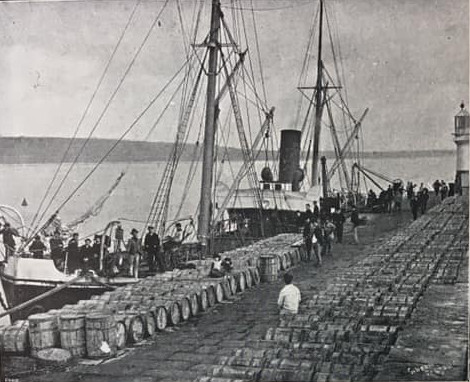 period of fourteen years, register less than 19° at Penzance, and that only once. The lowest
readings over a period of years gave Penzance, 22°; London, 11°; Exmouth, 8°; Scotland,
0; while in summer the mean temperature at noon in Penzance was, 73° for June and July; 72°
for August; in London during the same period it was 83° June, 80° July and 79° August.
The daily difference of temperature between the day and night is also remarkably slight, the
averages showing not more that from 3° to 4° between the minimum of the night and the
maximum of the day.
period of fourteen years, register less than 19° at Penzance, and that only once. The lowest
readings over a period of years gave Penzance, 22°; London, 11°; Exmouth, 8°; Scotland,
0; while in summer the mean temperature at noon in Penzance was, 73° for June and July; 72°
for August; in London during the same period it was 83° June, 80° July and 79° August.
The daily difference of temperature between the day and night is also remarkably slight, the
averages showing not more that from 3° to 4° between the minimum of the night and the
maximum of the day.
No doubt the over-riding cause of these facts is the proximity of the ocean, for the mass of water preserves a far more even temperature than the air, and its effect is shown here in remarkable degree in preserving equilibrium. Dr. Forbes states that the temperature only thirty miles from Penzance inland is 2° colder in January, and 2° warmer in July, but we canot emphasis this more clearly than by referring to the latest results shown above, compiled by Mr. C. H. Benn, of Penzance. in which the monthly mean temperature is shown alongside of other watering places in the South of England.
These separate testimonies point to facts that deserve to be more widely recognised. When we
remember the severity of the snow storms and frost recently reported from the Riviera and the
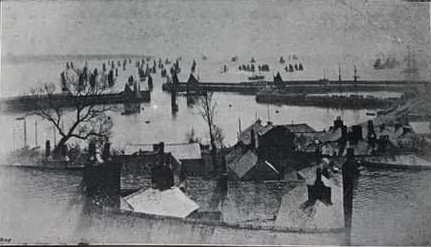 South of France, and learn that there has practically been no snow or frost at Penzance for several
years past, one need not wonder at being told by invalids in those southern latitudes, that after
being in the hot sun, the keen air on the shady side of the street is almost killing at noonday.
Such an experience is very rare indeed at Penzance, and for that reason alone it is a most
favourable place in winter for persons of weakly constitutions or
South of France, and learn that there has practically been no snow or frost at Penzance for several
years past, one need not wonder at being told by invalids in those southern latitudes, that after
being in the hot sun, the keen air on the shady side of the street is almost killing at noonday.
Such an experience is very rare indeed at Penzance, and for that reason alone it is a most
favourable place in winter for persons of weakly constitutions or
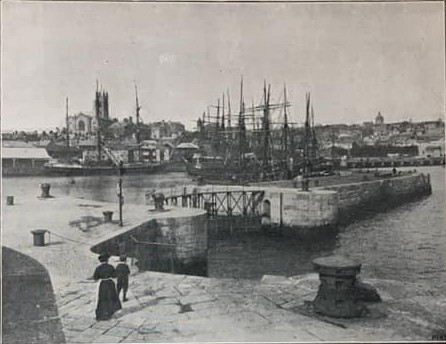 suffering from pulmonary or asthmatic complaints. But beyond this we put it forward now as desirable
from its social aspects, for in these days of travel, when wealthy merchants and others can so
conveniently select their homes at distances from the Metropolitan centres, which would have been
impossible fifty years ago, a town like Penzance needs but be known to be appreciated. From our
illustrations it will be seen that it is situated in a most interesting neighbourhood in the western
dip of Mount’s Bay, facing almost due south, with the Lizard Point stretching out some sixteen or
eighteen miles on the eastern side, and a range of undulating hills on the west rendered
increasingly picturesque by the white cottages of the fishing town Newlyn, rising upon tier over the
masts of many boats to be seen inside the harbour.
suffering from pulmonary or asthmatic complaints. But beyond this we put it forward now as desirable
from its social aspects, for in these days of travel, when wealthy merchants and others can so
conveniently select their homes at distances from the Metropolitan centres, which would have been
impossible fifty years ago, a town like Penzance needs but be known to be appreciated. From our
illustrations it will be seen that it is situated in a most interesting neighbourhood in the western
dip of Mount’s Bay, facing almost due south, with the Lizard Point stretching out some sixteen or
eighteen miles on the eastern side, and a range of undulating hills on the west rendered
increasingly picturesque by the white cottages of the fishing town Newlyn, rising upon tier over the
masts of many boats to be seen inside the harbour.
The parade, some sixty feet wide for most of its length, and paved with patent stone [concrete?],
extends along the sea wall from the Old Battery point to the public baths, and a more pleasant
promenade it would not be easy to find. The bay in its varying phases an ever changing source of
pleasure, teems with fish and possibilities for aquatic amusements of every kind, boating, bathing,
fishing, excursions by steamer, or strolls on the sands, beach and rocks. The famous St. Michael’s
Mount, immediately on the left of the town, is one of the lions of the bay, and can be visited by
boat at any time, or on foot
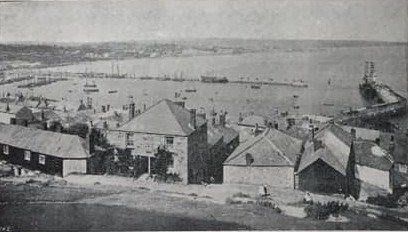 when the tide is low. There are plenty of fine residences available, both furnished and unfurnished,
and the inhabitants are warm-hearted, courteous, and ever ready in their endeavours to make a
stranger feel at home. For inland walks and drives, the district will compare with some of the
favoured portions of Devonshire or Kent, undulating and splendidly wooded, and for a few miles
around the town
when the tide is low. There are plenty of fine residences available, both furnished and unfurnished,
and the inhabitants are warm-hearted, courteous, and ever ready in their endeavours to make a
stranger feel at home. For inland walks and drives, the district will compare with some of the
favoured portions of Devonshire or Kent, undulating and splendidly wooded, and for a few miles
around the town
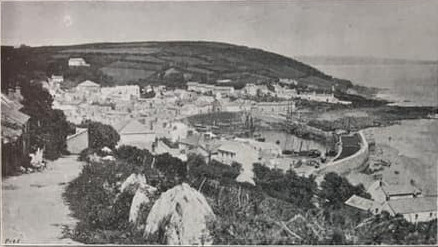 cultivated up to an unusually high standard; there is still within easy reach some of the grandest
and wildest of scenery to be found in any part of England. The northern shore of the peninsula from
Land’s End to St Ive’s, [sic] and a part of the south-western promontory is rugged, high, and
magnificently broken. Instead of undulating hills and well wooded, gently sloping valleys, the high
ground presents a scene of weird grandure. Huge granite blocks line the cliffs and protrude their
rugged forms on
cultivated up to an unusually high standard; there is still within easy reach some of the grandest
and wildest of scenery to be found in any part of England. The northern shore of the peninsula from
Land’s End to St Ive’s, [sic] and a part of the south-western promontory is rugged, high, and
magnificently broken. Instead of undulating hills and well wooded, gently sloping valleys, the high
ground presents a scene of weird grandure. Huge granite blocks line the cliffs and protrude their
rugged forms on
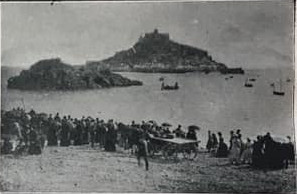 the top of every mound, in fact, stones of all conceivable shapes appear to have taken the place of
ordinary vegetation, for not a tree or a shrub is to be seen, though the district, which we more
fully describe further on, is one of the most interesting in Great Britain, both to the antiquarian
and to the geologist, and we might also add to the ordinary sightseer, for few of these will be
likely to come to Penzance without exploring the wonders of the great granite fissures and crags of
Land’s End, and their mighty associates which guard the first bit of English soil approachable from
the west.
the top of every mound, in fact, stones of all conceivable shapes appear to have taken the place of
ordinary vegetation, for not a tree or a shrub is to be seen, though the district, which we more
fully describe further on, is one of the most interesting in Great Britain, both to the antiquarian
and to the geologist, and we might also add to the ordinary sightseer, for few of these will be
likely to come to Penzance without exploring the wonders of the great granite fissures and crags of
Land’s End, and their mighty associates which guard the first bit of English soil approachable from
the west.
Penzance is not an old town, and although it is our object to place first and foremost in this
review its enviable and unique advantages as a winter residence for invalids, who may secure here
the
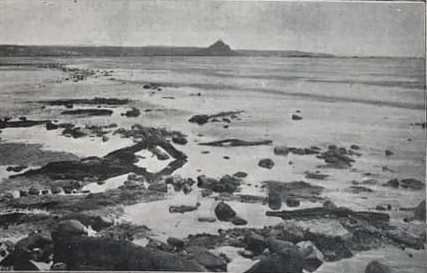 main benefits of a sea voyage without the risk, a short account of its rise and progress from a
fishing village to an important health resort, will perhaps increase the readers’ interest.
Tradition, Millett tells us, says “that about the year 1300 there existed a little headland, on
which were situated a few fishermen’s huts and a chapel dedicated to St. Anthony.” In the old
Cornish dialect Pen signifies head and sans
holy, and as St. Anthony was held in great veneration by Cornish fishermen, the distinction of
main benefits of a sea voyage without the risk, a short account of its rise and progress from a
fishing village to an important health resort, will perhaps increase the readers’ interest.
Tradition, Millett tells us, says “that about the year 1300 there existed a little headland, on
which were situated a few fishermen’s huts and a chapel dedicated to St. Anthony.” In the old
Cornish dialect Pen signifies head and sans
holy, and as St. Anthony was held in great veneration by Cornish fishermen, the distinction of
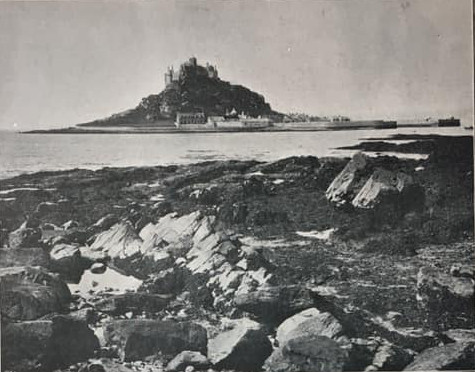 holy head or Pensans, according to Millett, was given to the spot from which the town derives
its present name. Present authorities do not believe in this derivation, and it is generally
accepted that Penzance is derived from the old Cornish name of Penzawn, which was in all
probability the early name of the head-land. The village was evidently progressive; in 1332 King
Edward III. granted it, at the insistance of the Lady of the Manor of Alverton, a weekly market on
Wednesdays, and a fair of seven days at the festival of St. Peter, from which charter the history of
Penzance may be said to start. By the middle of the 16th century it had become a trading port with
defences, for one of the oldest documents in possession of the Corporation is dated March 16th,
1512, and signed by Henry VIII., granting to the receiver, auditor and bailiffs of “our town of
Penzans” the profits of the “ankerage, kylage and busselage,” of all ships vising the harbour, on
condition that the bulwarks of the town are well and properly repaired. Twenty-five years later a
naval engagement took place in Mount’s Bay between a small English fleet under Admiral Seymour and
four French cruisers, one of which was sunk while the others escaped. In 1595 a Spanish force landed
and burnt Newlyn, Penzance, Mousehole and Paul to the ground, the inhabitants fleeing before the
disciplined and well armed sailors. This is the only incident of Spaniards landing in England on
hostile intent, and it is well to learn that in spite of heavy losses, and the
holy head or Pensans, according to Millett, was given to the spot from which the town derives
its present name. Present authorities do not believe in this derivation, and it is generally
accepted that Penzance is derived from the old Cornish name of Penzawn, which was in all
probability the early name of the head-land. The village was evidently progressive; in 1332 King
Edward III. granted it, at the insistance of the Lady of the Manor of Alverton, a weekly market on
Wednesdays, and a fair of seven days at the festival of St. Peter, from which charter the history of
Penzance may be said to start. By the middle of the 16th century it had become a trading port with
defences, for one of the oldest documents in possession of the Corporation is dated March 16th,
1512, and signed by Henry VIII., granting to the receiver, auditor and bailiffs of “our town of
Penzans” the profits of the “ankerage, kylage and busselage,” of all ships vising the harbour, on
condition that the bulwarks of the town are well and properly repaired. Twenty-five years later a
naval engagement took place in Mount’s Bay between a small English fleet under Admiral Seymour and
four French cruisers, one of which was sunk while the others escaped. In 1595 a Spanish force landed
and burnt Newlyn, Penzance, Mousehole and Paul to the ground, the inhabitants fleeing before the
disciplined and well armed sailors. This is the only incident of Spaniards landing in England on
hostile intent, and it is well to learn that in spite of heavy losses, and the
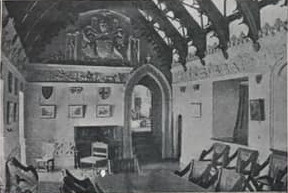
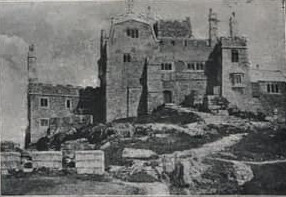
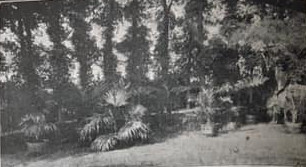 almost complete destruction of buildings, it was but nineteen years later that a petition to
incorporate Penzance as a borough was granted by James I.; under his charter the Mayor, Aldermen and
commonalty were allowed to use a common seal. The Corporation consisted of a Mayor (John Madern
being the first), eight Aldermen and eight assistants, a constitution which continued until the
passing of the Municipal Act of 1835, when the borough became divided into two wards, and its
government was vested in
almost complete destruction of buildings, it was but nineteen years later that a petition to
incorporate Penzance as a borough was granted by James I.; under his charter the Mayor, Aldermen and
commonalty were allowed to use a common seal. The Corporation consisted of a Mayor (John Madern
being the first), eight Aldermen and eight assistants, a constitution which continued until the
passing of the Municipal Act of 1835, when the borough became divided into two wards, and its
government was vested in
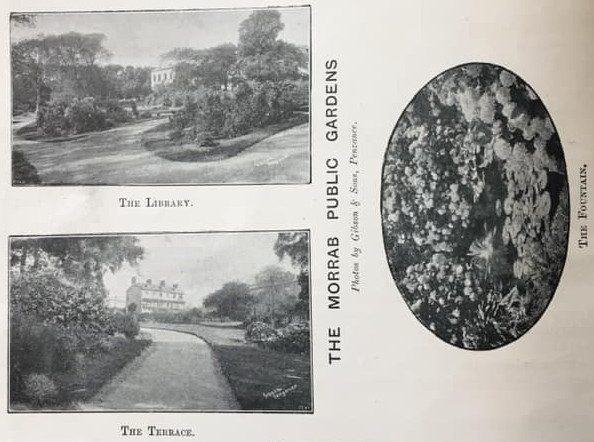
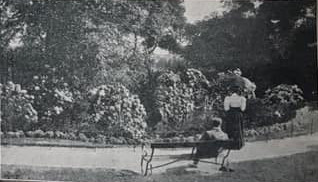 a Mayor, six Aldermen, and eighteen
Councillors. The townsmen passed through troublous times during
the Commonwealth, being from first to last loyal to the king; they were attacked and plundered by a
parliamentary army under Fairfax in 1646, and again in 1648 by a force under Colonel Bennett. With
the restoration, however, came better times and a general improvement. The Queen of Charles II. is
believed to have visited the borough in 1661, and in 1663 it was granted a charter for the coining
or assaying of tin for the Duchy of Cornwall, from which valuable privileges were secured. The
general prosperity seems to have continued pretty evenly from this time. The mining of tin and
copper in the district, and the exportation of these metals as well as of large quantities of fish,
brought wealth and revenue. The harbour and quays were greatly extended, the streets gradually
acquired the appearance of a highly prosperous town. Churches and chapels, charities, clubs, a fine
library and other institutions were inaugurated, and a general improvement in the modes and habits
of life became almost universal. As the metropolis of a large outlying district, Penzance was crowded
on market days with buyers and sellers of farm produce and all kinds of merchandise, and the shop
keepers did business with the farmers, miners, and country gentry for
a Mayor, six Aldermen, and eighteen
Councillors. The townsmen passed through troublous times during
the Commonwealth, being from first to last loyal to the king; they were attacked and plundered by a
parliamentary army under Fairfax in 1646, and again in 1648 by a force under Colonel Bennett. With
the restoration, however, came better times and a general improvement. The Queen of Charles II. is
believed to have visited the borough in 1661, and in 1663 it was granted a charter for the coining
or assaying of tin for the Duchy of Cornwall, from which valuable privileges were secured. The
general prosperity seems to have continued pretty evenly from this time. The mining of tin and
copper in the district, and the exportation of these metals as well as of large quantities of fish,
brought wealth and revenue. The harbour and quays were greatly extended, the streets gradually
acquired the appearance of a highly prosperous town. Churches and chapels, charities, clubs, a fine
library and other institutions were inaugurated, and a general improvement in the modes and habits
of life became almost universal. As the metropolis of a large outlying district, Penzance was crowded
on market days with buyers and sellers of farm produce and all kinds of merchandise, and the shop
keepers did business with the farmers, miners, and country gentry for
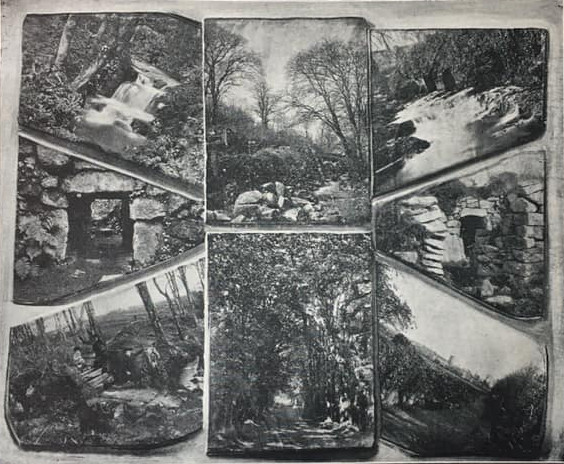 miles around. The advent of railways gave the town a filip in quite another direction, and the Great
Western Railway extension quickly brought visitors from distant places, some attracted by it
nearness to Land’s End and the grandure of ts local scenery, others by the growing notoriety of its
wonderfully equitable climate. Since the opening of the railway new roads and terraces have sprung
up, and the dwelling houses have assumed proportions in keeping with its new character as a
sea-side resort and fashionable watering place. Although the mining industry has been on the wane
for a number of years, indeed has almost ceased to exist in many parts of Cornwall, Penzance has
thriven and prospered. The Corporation are alive to its best interests, and on the alert to forward
every movement likely to benefit the town. During the past few years they have purchased the Morrab
miles around. The advent of railways gave the town a filip in quite another direction, and the Great
Western Railway extension quickly brought visitors from distant places, some attracted by it
nearness to Land’s End and the grandure of ts local scenery, others by the growing notoriety of its
wonderfully equitable climate. Since the opening of the railway new roads and terraces have sprung
up, and the dwelling houses have assumed proportions in keeping with its new character as a
sea-side resort and fashionable watering place. Although the mining industry has been on the wane
for a number of years, indeed has almost ceased to exist in many parts of Cornwall, Penzance has
thriven and prospered. The Corporation are alive to its best interests, and on the alert to forward
every movement likely to benefit the town. During the past few years they have purchased the Morrab
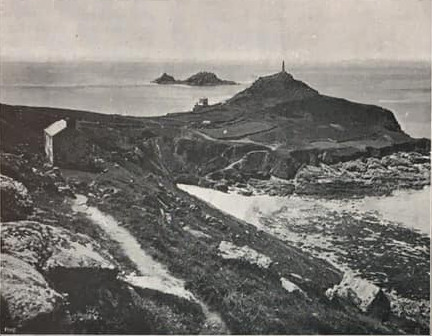 Gardens for the public, extended the promenade, erected the public buildings in the Alverton Road,
and spent large sums in perfecting the sanitary system, a matter which has just been strongly
brought to the front by a letter from the late chairman of the County Sanitary Committee to the Town
Council of Penzance, from which we extract the following:—
Gardens for the public, extended the promenade, erected the public buildings in the Alverton Road,
and spent large sums in perfecting the sanitary system, a matter which has just been strongly
brought to the front by a letter from the late chairman of the County Sanitary Committee to the Town
Council of Penzance, from which we extract the following:—
“I am glad now to say, when relinquishing the chair of the County Sanitary Committee, that
Penzance
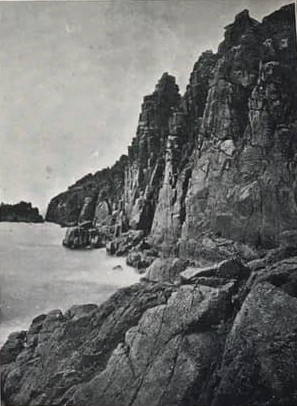 in my opinion stands in the proud position of being absolutely the first Urban Sanitary Authority in
the county, having the clearest and best conception of its duties and responsibilities in
sanitation, as shown by its steady progress and special expenditure during the last five years, and
that, thanks also to its two excellent health officers, it is the best and most systematically
looked after of any district in Cornwall. Vistors may therefore go there either during the winter or
the summer with every confidence in the sanitary condition of the place, and that nothing will be
allowed to militate against their health or their comfort in these respects; consequently, I trust
it will always continue to receive that patronage and support from other parts of Britain that the
advantages appertaining to the peculiar mildness and enjoyability of its climate so justly entitles
it.
in my opinion stands in the proud position of being absolutely the first Urban Sanitary Authority in
the county, having the clearest and best conception of its duties and responsibilities in
sanitation, as shown by its steady progress and special expenditure during the last five years, and
that, thanks also to its two excellent health officers, it is the best and most systematically
looked after of any district in Cornwall. Vistors may therefore go there either during the winter or
the summer with every confidence in the sanitary condition of the place, and that nothing will be
allowed to militate against their health or their comfort in these respects; consequently, I trust
it will always continue to receive that patronage and support from other parts of Britain that the
advantages appertaining to the peculiar mildness and enjoyability of its climate so justly entitles
it.
“I am, dear Sir, yours faithfully,
Silvanus Trevail.”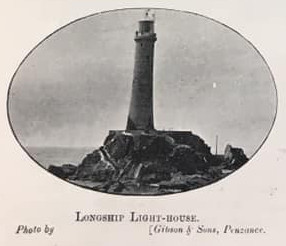
This testimony as to its sanitary condition brings us once more to Penzance as a winter
residence for invalids, especially those with bronchial ailments or any kind of chest complaint
or weakness. In the borough Meteorologist’s report for 1896, the mean temperature is shown as
53.3° (Jan., 46.46°; Feb., 46.73°; March, 50°; April, 52.77°; May, 57.83°;
June, 61.21°; July, 62.68°; August, 61.34°; Sept., 59.18°; Oct., 49.93°; Nov.,
45.47°; Dec., 45.94°); winter mean range, 4.53°; average daily sunshine, 5 hrs. 0
mins. 16½ secs.; rainfall during year, 31.87 inches. On two occasions only the temperature
fell below freezing point, 31° in December being the lowest recorded. Referring in his report
to these returns, Mr. R. D. Boase, Medical Officer of Health for the Urban Sanitary District,
remarks, “The equitability of the temperature, with the general high run and complete absence of
extremes, the large amount of average daily sunshine, the comparatively small rainfall [compared to
where?!], have together been most favourable to our residents and invalid visitors of all ages,”
bearing out the
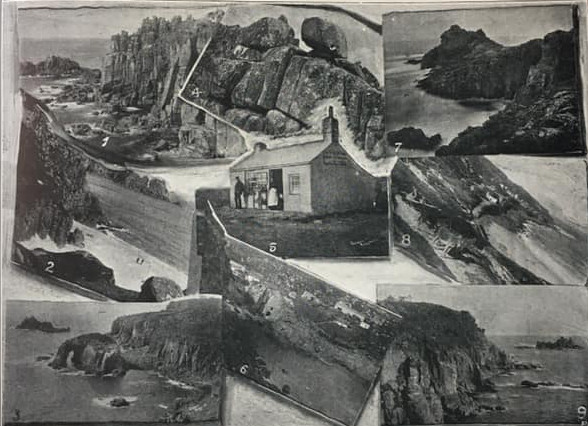 testimony of Dr. Paris, who resided here in 1856, when President of the College of Surgeons, and in
a brochure on Mount’s Bay wrote: “Its seasons may be compared to the neap tides neither
ebbing nor flowing with any great energy, Our winters may be denominated languid springs. Of all
places in England, Penzance offers the most material advantage from the mildness of its winter.” As
in 1856 so in 1896. Sir James Clarke observes, “It is a locality in which invalids can spend most
time in the open air;” and according to the late Sir Morell Mackenzie, this is the real test of a
health resort.
testimony of Dr. Paris, who resided here in 1856, when President of the College of Surgeons, and in
a brochure on Mount’s Bay wrote: “Its seasons may be compared to the neap tides neither
ebbing nor flowing with any great energy, Our winters may be denominated languid springs. Of all
places in England, Penzance offers the most material advantage from the mildness of its winter.” As
in 1856 so in 1896. Sir James Clarke observes, “It is a locality in which invalids can spend most
time in the open air;” and according to the late Sir Morell Mackenzie, this is the real test of a
health resort.
Penzance is withal a most attractive town, having pleasant roads and terraces sloping upwards
from
Mount’s Bay to a gentle eminence behind, with good hotels and well built houses, in the gardens of
which rare flowers and semi-exotics bloom luxuriantly. Veronicas and fuchsias grow into hedges and
trees, pelargoniums and flowering myrtles front the villas; azaleas, verbenas, acacias, the aloe,
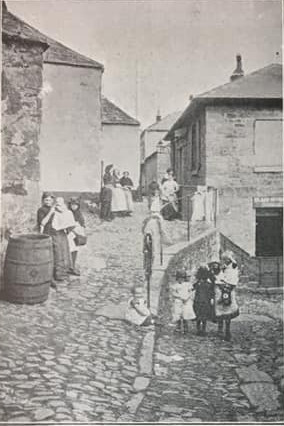 and a host of others attain to unusual size and perfection. Luxuriant! beautiful! are natural
expressions as the visitor passes from one corner to another, there are so many perfect gardens,
and so much that is interesting, because novel to our experience. They are evidence of that balmy
atmosphere which is often looked for abroad in the hope that it may call back the freshness and
bloom of health to the cheeks of those who are failing. To invalids themselves, to guardians and
medical men, these are facts which deserve attention. With the comfortable express carriages on the
Great Western and Midland Railways, Penzance is, so to speak, close to their doors, its southern
aspect facing a delightful bay, whose coast is a marvellous picture of changeful loveliness. Almost
surrounded by the ocean and direct in the track of the Gulf Stream, it is a treasure store of health
and vital energy, which thousands are vainly seeking, and in which all are invited to share.
and a host of others attain to unusual size and perfection. Luxuriant! beautiful! are natural
expressions as the visitor passes from one corner to another, there are so many perfect gardens,
and so much that is interesting, because novel to our experience. They are evidence of that balmy
atmosphere which is often looked for abroad in the hope that it may call back the freshness and
bloom of health to the cheeks of those who are failing. To invalids themselves, to guardians and
medical men, these are facts which deserve attention. With the comfortable express carriages on the
Great Western and Midland Railways, Penzance is, so to speak, close to their doors, its southern
aspect facing a delightful bay, whose coast is a marvellous picture of changeful loveliness. Almost
surrounded by the ocean and direct in the track of the Gulf Stream, it is a treasure store of health
and vital energy, which thousands are vainly seeking, and in which all are invited to share.
As to the capabilities of Penzance for fulfilling all the requirements of a fashionable town, there seems to have been great misconception. It is far in advance in this respect of many better known watering places. It is the chief town of an extensive district, and has large retail trading resources, good subscription and public libraries, science and art schools, a private club to which visitors can subscribe for long or short periods and educational opportunities of the highest order. A band plays frequently in the public gardens, and the Promenade and other walks and drives are in the highest degree attractive.
The whole of the West Cornish promontory from the Lizard Point to St. Ives and Land’s End is
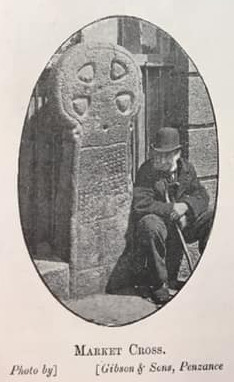
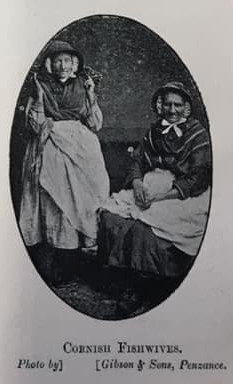 within the scope of daily drives, and it includes so much that is of absorbing interest, that we can
only give our readers a cursory description of its main features, by taking in detail a few of the
most prominent places to which Jersey cars and excursion steamers are running continuously during
the summer.
within the scope of daily drives, and it includes so much that is of absorbing interest, that we can
only give our readers a cursory description of its main features, by taking in detail a few of the
most prominent places to which Jersey cars and excursion steamers are running continuously during
the summer.
The neighbourhood of Penzance is full of surpassing interest. It is impossible to adequately
describe it, for to each visitor its many sided phases will appear in different guises. To commence
with Mount St. Michael, which stands sentinel-like in the
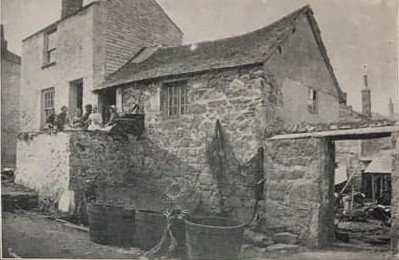 open bay, is full of romantic association, from the remotest periods to the time when its defences
were carried by assault, and the Duke of Hamilton, then a prisoner, liberated by the Parliamentary
army, in the reign of Charles I. It has been for ages a religious priory, visited by pilgrims for
sacred worship, occupied by monks and nuns and intriguers, but now simply a realistic ornament in
Mount’s Bay, its chapel a castle, and the “grand refectory” the dining-room of its noble owner, Lord
St. Levan. But who shall say in what mood you or another may visit the spot? Only yesterday the
chapel was decorated for the harvest festival. The decorations were nets and pilchards, boat spars,
and lines and hooks, for the harvest of the inhabitants is the harvest of the sea, and the reaping
time the drawing in of the nets when they are full. There is a small fishing village and a harbour,
a road up to and around the castle; on one side a gentle slope and easy approach, on the other
almost perpendicular cliffs of slate and granite, with St. Michael’s Chair poised on the top. Not an
easy chair, but one that has stood the buffet of te ages since St. Michael himself decreed
open bay, is full of romantic association, from the remotest periods to the time when its defences
were carried by assault, and the Duke of Hamilton, then a prisoner, liberated by the Parliamentary
army, in the reign of Charles I. It has been for ages a religious priory, visited by pilgrims for
sacred worship, occupied by monks and nuns and intriguers, but now simply a realistic ornament in
Mount’s Bay, its chapel a castle, and the “grand refectory” the dining-room of its noble owner, Lord
St. Levan. But who shall say in what mood you or another may visit the spot? Only yesterday the
chapel was decorated for the harvest festival. The decorations were nets and pilchards, boat spars,
and lines and hooks, for the harvest of the inhabitants is the harvest of the sea, and the reaping
time the drawing in of the nets when they are full. There is a small fishing village and a harbour,
a road up to and around the castle; on one side a gentle slope and easy approach, on the other
almost perpendicular cliffs of slate and granite, with St. Michael’s Chair poised on the top. Not an
easy chair, but one that has stood the buffet of te ages since St. Michael himself decreed
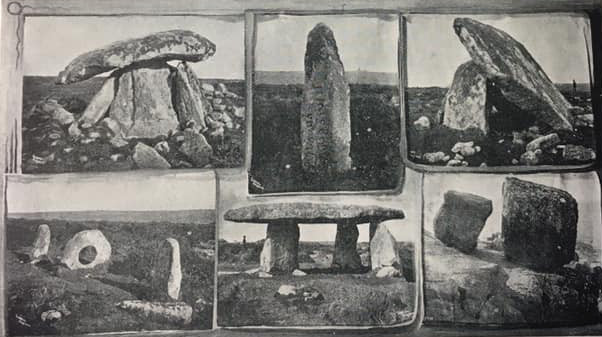
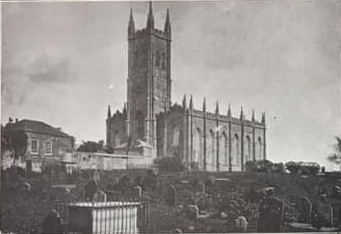 that wife or husband who sat upon it should gain the mastery. The top of the chapel tower is some
250 feet above the sea level, from which the outlook is imposing. The Mount is three miles from
Penzance, and can be reached by boat at high tide, or at low tide on foot from the village of
Marazion.
that wife or husband who sat upon it should gain the mastery. The top of the chapel tower is some
250 feet above the sea level, from which the outlook is imposing. The Mount is three miles from
Penzance, and can be reached by boat at high tide, or at low tide on foot from the village of
Marazion.
Land’s End comes next in point of interest: ten miles distant. The ordinary tourist will go, say,
by Jersey car, taking the Logan Rock or other rendezvous en route, according to programme,
and making the visit a pleasant day’s excursion. Absorbing topics for conversation will crop up on
the way, for the district is full of pathos literally written on stone. The starting by way
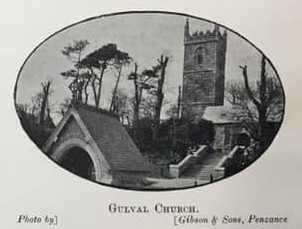 of Alverton leaves the lovely scenery of Castle Horneck on the right, and a pretty drive through
well wooded country brings us to Buryas Bridge and Trewidden, the Cornish home of T. B. Bolitho,
Esq., M.P. for the division. A cluster of village homes in a glen here by the road-side makes a
sweet pastoral picture. Then the road lies upward to St. Buryan, once the seat of a college of
Augustine canons, but now an uninteresting village, save for its church and two ancient crosses,
one within the churchyard and one in the road close to its gates. The tower stands 460 feet above
sea level. Two miles further on, by a circuitous road crossing another valley, is the village of
Treen, from which a half mile walk across a field path is needed to reach Treen Point, and the
famous
of Alverton leaves the lovely scenery of Castle Horneck on the right, and a pretty drive through
well wooded country brings us to Buryas Bridge and Trewidden, the Cornish home of T. B. Bolitho,
Esq., M.P. for the division. A cluster of village homes in a glen here by the road-side makes a
sweet pastoral picture. Then the road lies upward to St. Buryan, once the seat of a college of
Augustine canons, but now an uninteresting village, save for its church and two ancient crosses,
one within the churchyard and one in the road close to its gates. The tower stands 460 feet above
sea level. Two miles further on, by a circuitous road crossing another valley, is the village of
Treen, from which a half mile walk across a field path is needed to reach Treen Point, and the
famous
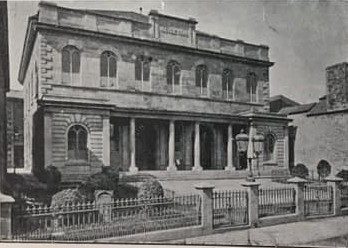 Logan Stone. A beauty, amounting to the sublime invests the vast unconventional massiveness of the
stupendous group of fissured granite on which the Logan—itself some ninety tons in
weight—is poised. It looks unapproachable, but assisted by a guide the most venturesome of the
party will find their way to the top, and perform the mystic feat of moving the rocky mass, as shown
in our picture. From this vantage point a bit of grand coast scenery is observed. Porthcurno Cove
is close on the right, where the Eastern Telegraph Company employ about 100 clerks sending
Logan Stone. A beauty, amounting to the sublime invests the vast unconventional massiveness of the
stupendous group of fissured granite on which the Logan—itself some ninety tons in
weight—is poised. It looks unapproachable, but assisted by a guide the most venturesome of the
party will find their way to the top, and perform the mystic feat of moving the rocky mass, as shown
in our picture. From this vantage point a bit of grand coast scenery is observed. Porthcurno Cove
is close on the right, where the Eastern Telegraph Company employ about 100 clerks sending
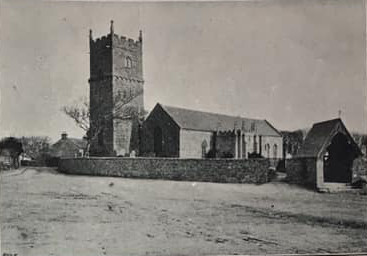 and receiving messages viá Lisbon and Gibraltar, etc., from almost all parts of the world.
The cove and valley is well worth a visit. From Treen or Porthcurno, Land’s End lies about five
miles coastwise, but our tourists will reach it by a shorter route. Avoiding Sennen Cove and passing
to the left of Sennen Church Town, they alight either at Land’s End Hotel or the last refreshment
house, close to the westernmost point of our island home. Bold, rugged, precipitous, cavernous
crags on each side, in front the shimmering ocean with the Longship rocks and light-house a short
distance out, and the Scilly Islands on the sky-line to the south-west; behind, a wild hilly
moorland,
and receiving messages viá Lisbon and Gibraltar, etc., from almost all parts of the world.
The cove and valley is well worth a visit. From Treen or Porthcurno, Land’s End lies about five
miles coastwise, but our tourists will reach it by a shorter route. Avoiding Sennen Cove and passing
to the left of Sennen Church Town, they alight either at Land’s End Hotel or the last refreshment
house, close to the westernmost point of our island home. Bold, rugged, precipitous, cavernous
crags on each side, in front the shimmering ocean with the Longship rocks and light-house a short
distance out, and the Scilly Islands on the sky-line to the south-west; behind, a wild hilly
moorland,
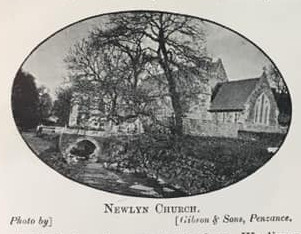 planted as it were with patches and plock of granite.
planted as it were with patches and plock of granite.
Across Whitsand Bay, Cape Cornwall stands well out to the north, and on the left, close at hand
is the group of rocks known as the Armed Knight. The scene is inimitable, and the interest it
awakens is the stranger enthralling. It fascinates the imagination, and evokes the desire to mount
the rocks, to go out as near to the extreme edge as possible, to peer over each particular
precipice into the cavernous depths, and watch the waves surging, foaming, shimmering, in unceasing,
restless activity; here on terrorising masses of stone, there on the shining white sand which gives
its name to the bay. We linger on as the sun recedes, with mind awakened to
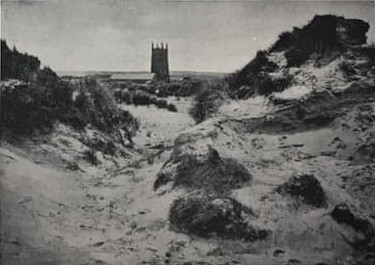 unusual tension. These mighty
rocks! These majestic cliffs! Are they not emblematical of the solidity of our race, the
invulnerability of our native land? At least we think so, and when at last it is impossible to delay
the return journey longer, we feel a new sense of elation, a boastful satisfaction, that this is our
own Land’s End.
unusual tension. These mighty
rocks! These majestic cliffs! Are they not emblematical of the solidity of our race, the
invulnerability of our native land? At least we think so, and when at last it is impossible to delay
the return journey longer, we feel a new sense of elation, a boastful satisfaction, that this is our
own Land’s End.
But this Day’s excursion will merely have shown two interesting bits on the fifty miles coastline
lying within driving distance of Penzance, which with few exceptions is remarkably precipitous, and
contains some of the finest cliff scenery in Great Britain. We can
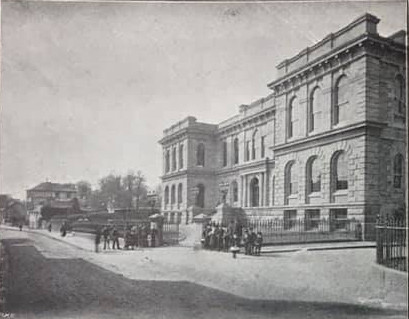 only name in passing a few of the most noticeable effects. At Penlee Point, by Mousehole, the
farthest that can be seen west from the town, a fine view is obtained of the eastern side of
Mount’s Bay, with Penzance, Marazion, St. Michael’s Mount, and the coast-line to the Lizard.
Mousehole itself is an old time fishing village with a harbour at least 600 years old. In the
churchyard of St. Paul, a village rising above Mousehole, is the tomb of Dolly Pentreath, mentioned
by Daines Barrington in the “Archælogia” as the last person who conversed in the ancient
Cornish language before it
only name in passing a few of the most noticeable effects. At Penlee Point, by Mousehole, the
farthest that can be seen west from the town, a fine view is obtained of the eastern side of
Mount’s Bay, with Penzance, Marazion, St. Michael’s Mount, and the coast-line to the Lizard.
Mousehole itself is an old time fishing village with a harbour at least 600 years old. In the
churchyard of St. Paul, a village rising above Mousehole, is the tomb of Dolly Pentreath, mentioned
by Daines Barrington in the “Archælogia” as the last person who conversed in the ancient
Cornish language before it
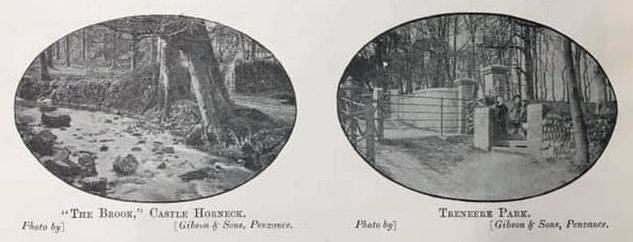
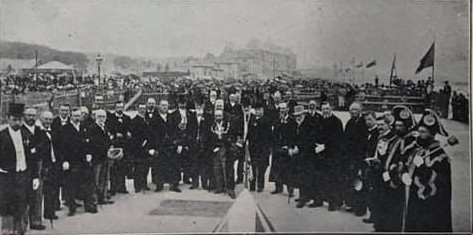 expired in the 18th century. Just beyond Mousehole, is a cave in the cliffs some hundred feet deep
with beautiful stalactites and ferns growing from the roof. Then comes Carn Du, or Black Rock, and
Lamorna Cove, a most interesting spot for an afternoon’s excursion as it opens into a charming
valley.
expired in the 18th century. Just beyond Mousehole, is a cave in the cliffs some hundred feet deep
with beautiful stalactites and ferns growing from the roof. Then comes Carn Du, or Black Rock, and
Lamorna Cove, a most interesting spot for an afternoon’s excursion as it opens into a charming
valley.
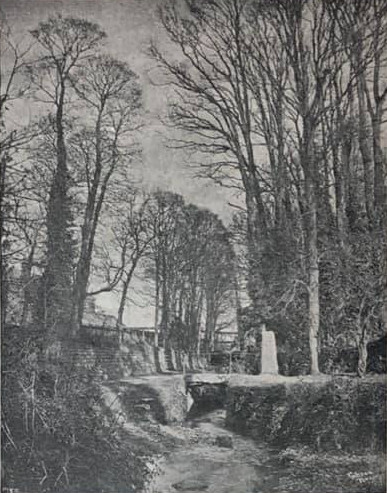 There is another cave here, and a stretch of the beach is formed of immense boulders, a wonderful
contrast to the shining sand of Portcurno Cove only a few miles further on, full of small
glittering shells, but as we have before stated, Portcurno is worth a day’s outing. Proceeding,
we pass Carn Bargas, a remarkable headland with a massive pedestal of granite on its summit nine
feet high and eight broad. A mile further is Carn Boscawen, also a giant headland, in the face of
which a slab fourteen feet long is resting on three enormous pillars. Then come St. Loy Cove, and
Penberth Cove, with its picturesque fishing village, pretty valley, and crystal trout stream. Near
it is a cave, the roof of which is finely studded with boulders. About a mile farther, passing the
Logan Rock and Porthcurno, we come to Tol-Pedn-Penwith, the Holed Headland of Penwith, which
forms the western extremity of Mount’s Bay. The rocks here are the finest on the western coast.
Rising almost perpendicularly 200 feet from the sea, immense columnar rocks rise cube over cube as
if an almighty hand had placed them in orderly sections. Close to the headland is a huge funnel
shaped hole descending from the surface to a cave which communicates with the sea. It is possible
to explore it from the entrance to the west of Tol-pedn at low water, but account must be
taken of
There is another cave here, and a stretch of the beach is formed of immense boulders, a wonderful
contrast to the shining sand of Portcurno Cove only a few miles further on, full of small
glittering shells, but as we have before stated, Portcurno is worth a day’s outing. Proceeding,
we pass Carn Bargas, a remarkable headland with a massive pedestal of granite on its summit nine
feet high and eight broad. A mile further is Carn Boscawen, also a giant headland, in the face of
which a slab fourteen feet long is resting on three enormous pillars. Then come St. Loy Cove, and
Penberth Cove, with its picturesque fishing village, pretty valley, and crystal trout stream. Near
it is a cave, the roof of which is finely studded with boulders. About a mile farther, passing the
Logan Rock and Porthcurno, we come to Tol-Pedn-Penwith, the Holed Headland of Penwith, which
forms the western extremity of Mount’s Bay. The rocks here are the finest on the western coast.
Rising almost perpendicularly 200 feet from the sea, immense columnar rocks rise cube over cube as
if an almighty hand had placed them in orderly sections. Close to the headland is a huge funnel
shaped hole descending from the surface to a cave which communicates with the sea. It is possible
to explore it from the entrance to the west of Tol-pedn at low water, but account must be
taken of
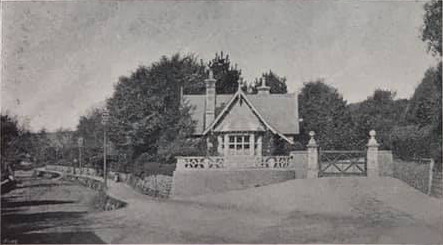 the tide to admit of returning by same route. Carnbarra and Pordennick are the two next great
headlands, but between them is Mill Vry, where there are four caverns and the remains of old
machinery used for raising sea-weed up a precipice. At Pordennick, again, the masses of granite
are piled up to a great height with the regularity of masonry. Two furlongs north is Enys Dodnan,
a rocky islet,
the tide to admit of returning by same route. Carnbarra and Pordennick are the two next great
headlands, but between them is Mill Vry, where there are four caverns and the remains of old
machinery used for raising sea-weed up a precipice. At Pordennick, again, the masses of granite
are piled up to a great height with the regularity of masonry. Two furlongs north is Enys Dodnan,
a rocky islet,
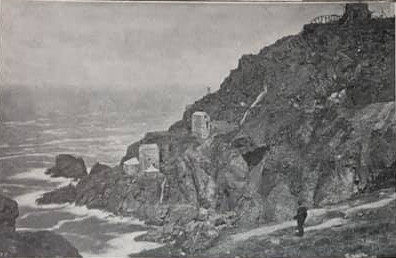 perforated by a lofty archway; and just beyond, another group, close to Land’s End, known as the
Armed Knight. Tradition says that the name arose from the large stone figure of a man surmounting
the pile, which was thrown down by a hurricane on the day King Charles I. was beheaded. Half a
mile north-east of Land’s End is Pedn-men-du, 140 feet high, just above Sennen Cove and
fishing village in Whitsand Bay. Hual Oak Point and Pornanven Cove—the part of the
Rocky
perforated by a lofty archway; and just beyond, another group, close to Land’s End, known as the
Armed Knight. Tradition says that the name arose from the large stone figure of a man surmounting
the pile, which was thrown down by a hurricane on the day King Charles I. was beheaded. Half a
mile north-east of Land’s End is Pedn-men-du, 140 feet high, just above Sennen Cove and
fishing village in Whitsand Bay. Hual Oak Point and Pornanven Cove—the part of the
Rocky
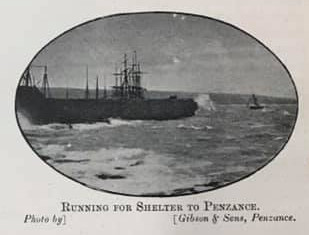 Valley—next appear; then Bosavern Cot, a rich valley in which beautiful forrest scenery bursts
upon one like an oasis, and makes a charming contrast to the desolate grandure of the cliffs. The
two high rocks to the left about half a mile out are the Brissons, and beyond, after passing
Carrick Glooze, a triple headland, and Priest Cove, or Porth Just, we reach Cape Cornwall,
a steep conical hill joined to the mainland by an isthmus. Kenidjack Castle, a fine headland, lies
midway between Cape Cornwall and the Botallack Mines, of which we give views. The workings in these
mines ran far out under the sea. Pendeen Cove, Boscaswell, Bosigran, Clift
Valley—next appear; then Bosavern Cot, a rich valley in which beautiful forrest scenery bursts
upon one like an oasis, and makes a charming contrast to the desolate grandure of the cliffs. The
two high rocks to the left about half a mile out are the Brissons, and beyond, after passing
Carrick Glooze, a triple headland, and Priest Cove, or Porth Just, we reach Cape Cornwall,
a steep conical hill joined to the mainland by an isthmus. Kenidjack Castle, a fine headland, lies
midway between Cape Cornwall and the Botallack Mines, of which we give views. The workings in these
mines ran far out under the sea. Pendeen Cove, Boscaswell, Bosigran, Clift
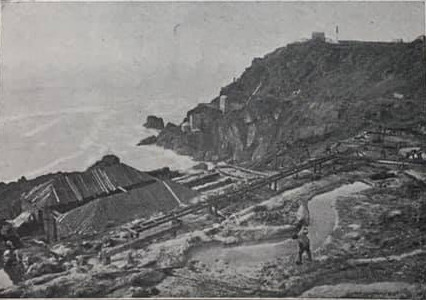 Castle, Morvah, and Porthmear Coves are passed ere we approach the Gurnards Head, the finest
headland on this part of the coast. We are now fairly in the Bristol Channel and looking due north
into the Irish Sea. St Ive’s [sic] is but a few miles beyond us, and all the way the grand
magnificence of the granite rocks is associated with clift castles, cromlechs, and historical
associations of the deepest interest. The visitor, whatever his tastes may be, will find amusement
and instruction. For
Castle, Morvah, and Porthmear Coves are passed ere we approach the Gurnards Head, the finest
headland on this part of the coast. We are now fairly in the Bristol Channel and looking due north
into the Irish Sea. St Ive’s [sic] is but a few miles beyond us, and all the way the grand
magnificence of the granite rocks is associated with clift castles, cromlechs, and historical
associations of the deepest interest. The visitor, whatever his tastes may be, will find amusement
and instruction. For
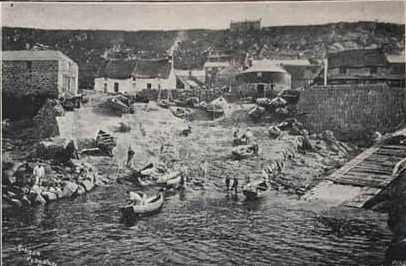 mineralogists there is no wider field for research; the geologist will be equally engrossed, for
although the peninsula consists chiefly of granite, it is very various in kind, and its intermixture
with slate occurs frequently: at St. Michael’s Mount in most remarkable formations. There are also
some remarkable alluvial deposits in Mount’s Bay.
mineralogists there is no wider field for research; the geologist will be equally engrossed, for
although the peninsula consists chiefly of granite, it is very various in kind, and its intermixture
with slate occurs frequently: at St. Michael’s Mount in most remarkable formations. There are also
some remarkable alluvial deposits in Mount’s Bay.
The scenery on the coast-line from Penzance to the Lizard Point is of quite a different character. A long stretch of sand occurs before reaching Marazion, after which the rocks and coves, though very beautiful, are less precipitous, and the granite formation gradually disappears, giving place to serpentine, a moderately hard stone, which we believe, is found only in this district. It is very beautifully marked, and specimens of it are worked up into models and ornaments, and largely sold as souvenirs of the district. Kynance Cove, near the Lizard, is a beautiful and remarkable spot, and Prussia Cove a few miles beyond St. Michael’s Mount, the famous smugglers’ haunt of old times, is a charming place for a summer picnic. The Lizard is about twenty-four miles distant, but Jersey cars run every day from Penzance during the summer. Excursions are also numerous to all the intermediate points.
A visit to the Scilly Islands wil also enter into the programme of visitors to the West of
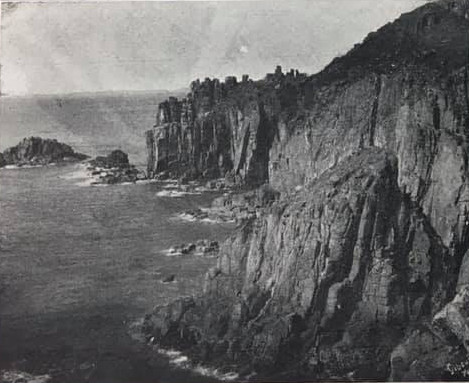 England. The voyage from Penzance in the West Cornwall Steamship Company’s “Lyonnesse” and “Lady of
the Isles” occupies about three and a half hours, and affords a magnificent view of the coast
scenery, the steamer passing close by Lamorna, the Logan Rock headland, and Tol-Pedn-Penwith,
and beyond the bell buoy at the Runnelstone, affording a fine prospect of the Land’s End, Longships
Light-house, Cape Cornwall
and the Brissons. After passing the famed Wolf Light-house, the eastern islands of Scilly come into
sight. The group consists of five inhabited islands and a large number of uninhabited islets and
rocks, which look charming from the hill tops of the larger islands.
England. The voyage from Penzance in the West Cornwall Steamship Company’s “Lyonnesse” and “Lady of
the Isles” occupies about three and a half hours, and affords a magnificent view of the coast
scenery, the steamer passing close by Lamorna, the Logan Rock headland, and Tol-Pedn-Penwith,
and beyond the bell buoy at the Runnelstone, affording a fine prospect of the Land’s End, Longships
Light-house, Cape Cornwall
and the Brissons. After passing the famed Wolf Light-house, the eastern islands of Scilly come into
sight. The group consists of five inhabited islands and a large number of uninhabited islets and
rocks, which look charming from the hill tops of the larger islands.
The steamers land their passengers at St. Mary’s—the largest of the group—on which the
hotels
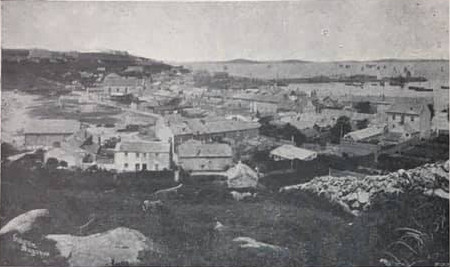 and principal lodging-houses are situated. This island is about nine miles in circumference, and the
rock scenery is extremely fine, especially the gigantic granite masses of Peninnis, including the
famous Pulpit Rock, and the Tooth Rock, near Peninnis Head. Near this spot is the largest Logan Rock
in England, and also a smaller one which, however, weighs some scores of tons, and is logged with
the greatest ease. The headland of Giant’s Castle is well worth a visit; and here is another Logan
Rock.
and principal lodging-houses are situated. This island is about nine miles in circumference, and the
rock scenery is extremely fine, especially the gigantic granite masses of Peninnis, including the
famous Pulpit Rock, and the Tooth Rock, near Peninnis Head. Near this spot is the largest Logan Rock
in England, and also a smaller one which, however, weighs some scores of tons, and is logged with
the greatest ease. The headland of Giant’s Castle is well worth a visit; and here is another Logan
Rock.
No visitor to St. Mary’s should omit to walk around the Garrison, which can be done in about half an hour from the pier or either of the hotels. A well kept road leads around inside the old fortification walls of a peninsular about half a mile in diameter, the greater portion of which is covered with heath, bracken and gorse; and a fine view is obtained both of the northern and western islands and rocks, and the light-houses on the Bishop Rock and St. Agnes.
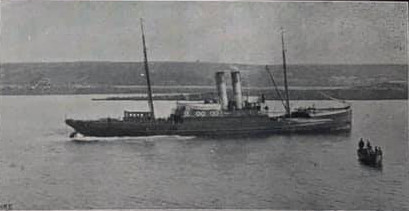 The next island in importance is Tresco, the residence of the Lord Proprietor, Mr. T. Algernon
Dorrien Smith, whose gardens are freely open to visitors, and are celebrated on account of the great
variety of semi-tropical plants, such as tree-ferns, draconias, eucalipti, aloes, bamboos, etc.,
which flourish luxuriantly in the open air. Geraniums and fuchsias are very fine, and grow to a
great size. In the summer months, the rockery near the mansion is ablaze with the bright flowers of
many varieties of the mesembrianthemum, or ice plant. In these gardens are situated the ruins of the
old abbey of St. Nicholas. Piper’s Hole, a very fine cavern, which contains a pond which has to be
crossed in a boat, is situated on the north coast of this island. On the coast facing Bryher there
is a round tower, called Cromwell’s Castle, and
the remains of an older fortification on the hill above it. Bryher and Sampson are divided from
Tresco by a narrow channel; the former is inhabited, and one of the prettiest views on the islands
The next island in importance is Tresco, the residence of the Lord Proprietor, Mr. T. Algernon
Dorrien Smith, whose gardens are freely open to visitors, and are celebrated on account of the great
variety of semi-tropical plants, such as tree-ferns, draconias, eucalipti, aloes, bamboos, etc.,
which flourish luxuriantly in the open air. Geraniums and fuchsias are very fine, and grow to a
great size. In the summer months, the rockery near the mansion is ablaze with the bright flowers of
many varieties of the mesembrianthemum, or ice plant. In these gardens are situated the ruins of the
old abbey of St. Nicholas. Piper’s Hole, a very fine cavern, which contains a pond which has to be
crossed in a boat, is situated on the north coast of this island. On the coast facing Bryher there
is a round tower, called Cromwell’s Castle, and
the remains of an older fortification on the hill above it. Bryher and Sampson are divided from
Tresco by a narrow channel; the former is inhabited, and one of the prettiest views on the islands
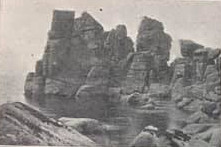
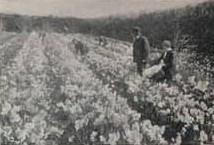 can be obtained from the top of the Northern Hill. Sampson is now uninhabited, but Sir Walter
Besant, in his novel, “Armorel of Lyonnesse,” make this island the home of his heroine.
can be obtained from the top of the Northern Hill. Sampson is now uninhabited, but Sir Walter
Besant, in his novel, “Armorel of Lyonnesse,” make this island the home of his heroine.
St. Agnes, another of the uninhabited islands, has magnificent rock scenery and a very fine
light-house. Beyond it lie the western islets and rocks, on which there have been many wrecks.
Annette, an uninhabited island about a mile long, lying to the west of St. Agnes, is in the spring
the home
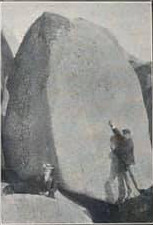 of an innumerable army of sea birds, especially puffins, who build their nests in holes in the
earth, and form traps which occasionally cause unwary pedestrians to stumble and fall on the soft
mounds of sea pink, with which the interior of the island is covered. St. Martin’s, the remaining
inhabited island, affords fine views of the eastern islands, which, covered with verdure to the
water’s edge, form a striking contrast to the wild and riocky western islets, and also to the
gigantic piles of Menavaur and Round Island, on the latter of which is a fine light-house recently
erected, and which lie to the north of Tresco and St. Martin’s. The outlying islands can be visited
from St. Mary’s by steam launch and sailing or rowing boats, and excellent fishing can almost always
be obtained.
of an innumerable army of sea birds, especially puffins, who build their nests in holes in the
earth, and form traps which occasionally cause unwary pedestrians to stumble and fall on the soft
mounds of sea pink, with which the interior of the island is covered. St. Martin’s, the remaining
inhabited island, affords fine views of the eastern islands, which, covered with verdure to the
water’s edge, form a striking contrast to the wild and riocky western islets, and also to the
gigantic piles of Menavaur and Round Island, on the latter of which is a fine light-house recently
erected, and which lie to the north of Tresco and St. Martin’s. The outlying islands can be visited
from St. Mary’s by steam launch and sailing or rowing boats, and excellent fishing can almost always
be obtained.
The principal productions of the islands are early vegetables and flowers. The trade in the
latter,
especially narcissi and daffodils, has increased very much in recent years, and in one day of
February in this year (1897) more than 5000 boxes of flowers—weighing over thirty
tons—were sent off by steamer. The fields in which they are grown are a beautiful sight,
frequently showing a mass of white and golden blossoms. Those who are unable to devote a longer
time, can during the months of July, August,
![Ruins of Old Abbey Fresco [sic], Scilly Isles. Ruins of Old Abbey Tresco, Scilly Isles](images/view19d.jpg)
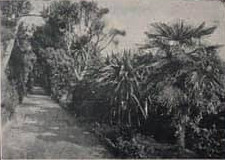 and September, make a day trip to the islands, which will enable them to get a general idea of the
beauties of the group, and also to pay a short visit to the gardens at Tresco. Information with
reference to the times of sailing of the steamers, etc., can be obtained from Mr. John Banfield,
the managing director of the steamship company, 6, North Parade, Penzance.
and September, make a day trip to the islands, which will enable them to get a general idea of the
beauties of the group, and also to pay a short visit to the gardens at Tresco. Information with
reference to the times of sailing of the steamers, etc., can be obtained from Mr. John Banfield,
the managing director of the steamship company, 6, North Parade, Penzance.
The public institutions of Penzance are many, and include the Public Buildings, in Alverton Street,
built of granite, and which cost £13,000, completed in 1867, from designs by the late Mr. John
Matthews, then Borough Surveyor, contain, in the central block, St. John’s Hall—a large
concert-hall seating 850 persons, recently re-decorated at a cost of £400—two lecture-halls,
chess-room,
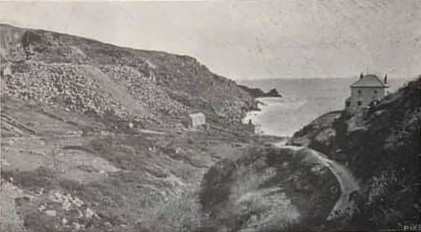 Penzance News-room and Institute. In the right wing are the Guildhall, Police Office, Council
Chamber, and municipal offices. The Royal Geological Society of Cornwall hold their meetings in the
left wing, where they have the best mineralogical and geological museum and library in the West of
England. The Natural History and Antiquarian Society have also a museum of local curiosities on the
second floor, at the back of the right wing. Morrab Public Gardens and Penzance Library was
purchased by the Corporation in 1889, and the grounds were tastefully laid out for public use.
Many sub-tropical plants, very rare in England, bloom here. Our views will give the reader some idea
of the beauty of the place. A band stand has just been erected, and the band plays several times
weekly in the season. Penzance Library, now in Morrab House, contains 23,000 volumes, and a rare
collection of dramatic works presented by Halliwell-Phillips, also the Dawson collection of
autographs and portraits. The reading-rooms are supplied with reviews, magazines, etc., for the use
of subscribers; short-term subscriptions are arranged for visitors. Penzance Free Public Library,
School of Art, and Mining, Science and Technical Schools are situated in a granite building with a
highly ornamental front in
Penzance News-room and Institute. In the right wing are the Guildhall, Police Office, Council
Chamber, and municipal offices. The Royal Geological Society of Cornwall hold their meetings in the
left wing, where they have the best mineralogical and geological museum and library in the West of
England. The Natural History and Antiquarian Society have also a museum of local curiosities on the
second floor, at the back of the right wing. Morrab Public Gardens and Penzance Library was
purchased by the Corporation in 1889, and the grounds were tastefully laid out for public use.
Many sub-tropical plants, very rare in England, bloom here. Our views will give the reader some idea
of the beauty of the place. A band stand has just been erected, and the band plays several times
weekly in the season. Penzance Library, now in Morrab House, contains 23,000 volumes, and a rare
collection of dramatic works presented by Halliwell-Phillips, also the Dawson collection of
autographs and portraits. The reading-rooms are supplied with reviews, magazines, etc., for the use
of subscribers; short-term subscriptions are arranged for visitors. Penzance Free Public Library,
School of Art, and Mining, Science and Technical Schools are situated in a granite building with a
highly ornamental front in
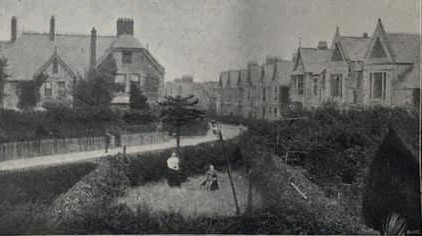 the Morrab Road. The library occupies the central portion, and is well stocked with books of
reference, etc. T. B. Bolitho, Esq., M.P., presented 1000 volumes, and there are now about 7000
volumes in all. There are lending and reference departments and a news-room. The schools are in
separate wings and are most efficiently conducted. The Penzance Camera Club have rooms in the Mining
and Science Schools.
the Morrab Road. The library occupies the central portion, and is well stocked with books of
reference, etc. T. B. Bolitho, Esq., M.P., presented 1000 volumes, and there are now about 7000
volumes in all. There are lending and reference departments and a news-room. The schools are in
separate wings and are most efficiently conducted. The Penzance Camera Club have rooms in the Mining
and Science Schools.
Penzance Club—situated on the Front, with a grand sea view—was opened September, 1896. It has 100 permanent members (residents of town and district), and attracts a large number of visitors as temporary members, for periods varying from one month to twelve on a small subscription. The premises comprise reading, smoking, and card-rooms, with an exceptionally fine, well lit billiard-room and two Burroughes and Watts’ tables. The Public Baths, on the Esplanade, for hot or cold fresh or salt baths, from early morning to late at night. There is a swimming bath seventy-five feet long and twenty-eight feet wide.
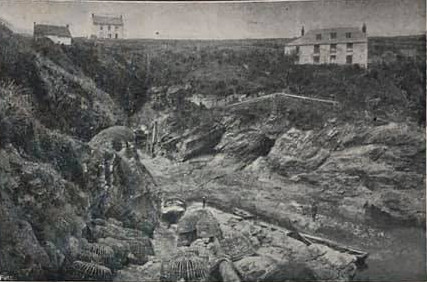 It will be seen from our views that places of public worship are numerous. St. Mary’s Church was
erected in 1835. On its site there existed an old church, or chapel, of St. Mary’s, with a spire,
which was consecrated in 1680. The tower, with battlements and pinacle, is its finest feature, and
is conspicuous from the sea; it has a carillon and peel of bells. There is a serpentine font in the
church, and a good organ. St. Paul’s Church, a very pretty edifice of granite, was constructed in
1843. The granite chancel rail and solid granite pulpit are striking features. St. John the
Baptist’s Church, near the station, was erected in 1882. The Wesleyans are a strong body, and the
principal church, in Chapel Street, is a fine building. The Baptists, Independents, Roman Catholics,
and other sects have also their special churches. The Young Men’s Christian Association in Causeway
Head is well attended, and has an influential committee. Its annual subscription of five shillings
enables members to visit any Y.M.C.A. in the world.
It will be seen from our views that places of public worship are numerous. St. Mary’s Church was
erected in 1835. On its site there existed an old church, or chapel, of St. Mary’s, with a spire,
which was consecrated in 1680. The tower, with battlements and pinacle, is its finest feature, and
is conspicuous from the sea; it has a carillon and peel of bells. There is a serpentine font in the
church, and a good organ. St. Paul’s Church, a very pretty edifice of granite, was constructed in
1843. The granite chancel rail and solid granite pulpit are striking features. St. John the
Baptist’s Church, near the station, was erected in 1882. The Wesleyans are a strong body, and the
principal church, in Chapel Street, is a fine building. The Baptists, Independents, Roman Catholics,
and other sects have also their special churches. The Young Men’s Christian Association in Causeway
Head is well attended, and has an influential committee. Its annual subscription of five shillings
enables members to visit any Y.M.C.A. in the world.
There are four principal banking instituions—The Consolidated Bank of Cornwall, or
Bolitho’s
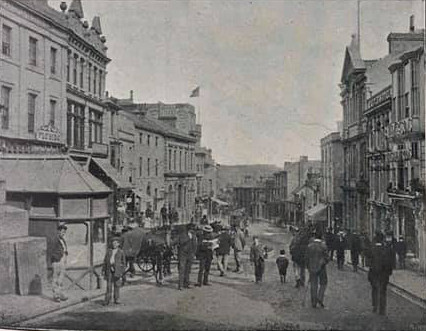 Bank, in Market Jew Street; The Cornish Bank in Queen’s Square; the Devon and Cornwall
Bank, Market Place; and the Capital and Counties Bank, Market Place. Of these the most important is
the Consolidated, which under the proprietorship of Messrs. Bolitho, Williams, Foster, Coode, Grylls
and Co., Ltd., as a financial institutions may be considered one of the vertebræ of Cornwall.
Every Cornishman knows and respects “Bolitho’s Bank.” He has been brought up to regard it as
something approaching the acme of Cornish financial soundness and commercial stability. But the
Bolitho’s Bank of to-day is hardly the Bolitho’s of yesterday and the day before. The Bolitho’s
which was familiar in Cornwall a decade ago was the private bank
Bank, in Market Jew Street; The Cornish Bank in Queen’s Square; the Devon and Cornwall
Bank, Market Place; and the Capital and Counties Bank, Market Place. Of these the most important is
the Consolidated, which under the proprietorship of Messrs. Bolitho, Williams, Foster, Coode, Grylls
and Co., Ltd., as a financial institutions may be considered one of the vertebræ of Cornwall.
Every Cornishman knows and respects “Bolitho’s Bank.” He has been brought up to regard it as
something approaching the acme of Cornish financial soundness and commercial stability. But the
Bolitho’s Bank of to-day is hardly the Bolitho’s of yesterday and the day before. The Bolitho’s
which was familiar in Cornwall a decade ago was the private bank
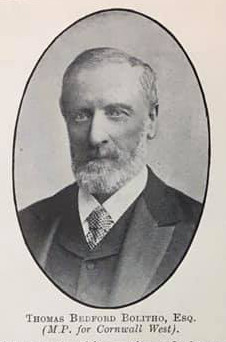 for many years carried on by members of the Bolitho family under the style of “Bolitho, Sons and
Co., Mount’s Bay Bank.” In 1889 this business was amalgamated with that of Messrs. Robins, Foster
and Co., East Cornwall Bank, other Cornish banking houses afterwards joining the company, and the
business is now carried on under the style of “Bolitho, Williams, Foster, Coode, Grylls and Co.,
Ltd., Consolidated Bank of Cornwall.” The bank is managed by a strong board of directors,
consisting of members of the firms of private bankers whose businesses were absorbed in the
amalgamation. The chairman of the directorate is Mr. Thomas Bedford Bolitho, whose history and
traditions have long been closely identified with the social and material interests of Cornwall.
The capital of the bank is £1,500,000, which is fully subscribed, and of which £300,000 is paid up.
The head office is at Penzance, and there are thirty-seven branches. We present our readers with a
portrait of Mr. T. B. Bolitho, M.P., of Trewidden, the Chairman, who is a Deputy-Lieutenant for
Cornwall, and the most influential man in this portion of the county.
for many years carried on by members of the Bolitho family under the style of “Bolitho, Sons and
Co., Mount’s Bay Bank.” In 1889 this business was amalgamated with that of Messrs. Robins, Foster
and Co., East Cornwall Bank, other Cornish banking houses afterwards joining the company, and the
business is now carried on under the style of “Bolitho, Williams, Foster, Coode, Grylls and Co.,
Ltd., Consolidated Bank of Cornwall.” The bank is managed by a strong board of directors,
consisting of members of the firms of private bankers whose businesses were absorbed in the
amalgamation. The chairman of the directorate is Mr. Thomas Bedford Bolitho, whose history and
traditions have long been closely identified with the social and material interests of Cornwall.
The capital of the bank is £1,500,000, which is fully subscribed, and of which £300,000 is paid up.
The head office is at Penzance, and there are thirty-seven branches. We present our readers with a
portrait of Mr. T. B. Bolitho, M.P., of Trewidden, the Chairman, who is a Deputy-Lieutenant for
Cornwall, and the most influential man in this portion of the county.
There are three newspapers published in Penzance, The Cornishman, with fifty-six columns,
on Thursdays and Saturdays, a most influential paper, and The Cornish Telegraph, on
Wednesdays; In connection with the latter, The Evening Tidings is a small sheet issued every
day except Wednesday, with an enlarged edition on Saturday. The Western Morning News,
published at Plymouth, has also
 a large circulation in the county, and may be considered the “daily” of the district.
a large circulation in the county, and may be considered the “daily” of the district.
A delightful feature of Penzance to which we have alluded but casually, is the interesting walks which abound. A very handy little guide, most useful for strangers, has been published under the auspices of the district Chamber of Commerce and is issued—with a well arranged map, giving distances, etc.—at sixpence. The roads, by-paths and names of places to be visited are very concisely pointed out. The map is also sold separately at one penny.
Our views are from a splendid series of nearly 200 photographs, taken personally in the district by Messrs. Gibson and Sons, and classified in albums at their studios for———
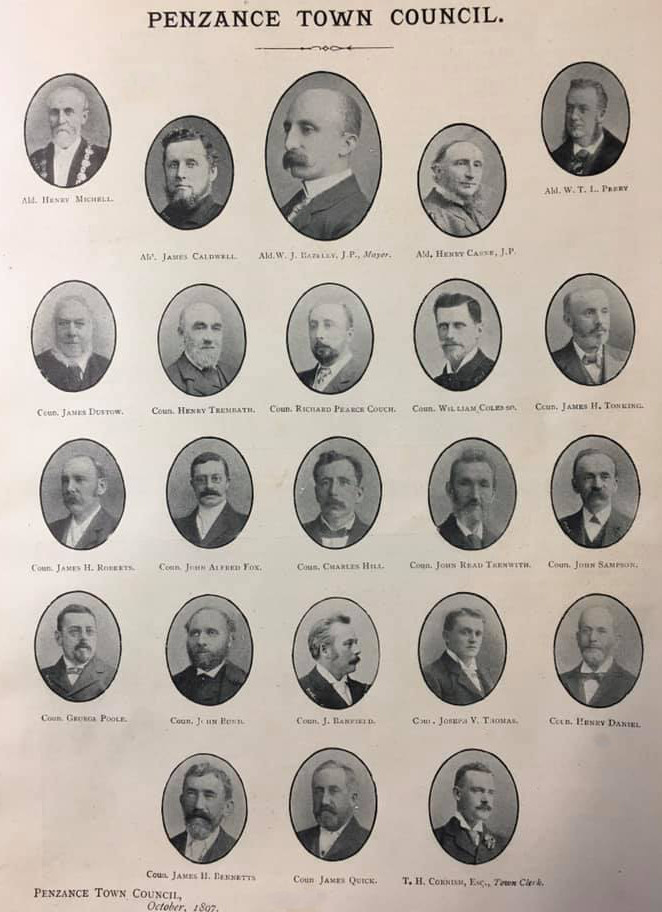

 Webmaster
Webmaster